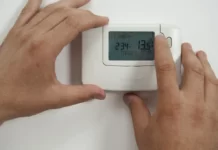Mold growing on the walls inside your home can cause serious problems with your health, like allergies, breathing problems, and infections. It can also weaken buildings and hurt furniture and other things in the home.
What is a Mold?
A mold is a type of fungus growing on damp or wet places or surfaces. It can grow both inside and outside our homes. It looks like a green, black, or white substance most of the time, and it can damage things like wood, drywall, and paper. Mold can cause problems with your health, such as allergies, breathing problems, and other problems. Mold growth needs to be taken care of as soon as possible to stop more damage and protect the health of people who live in or near the affected area.
Mold growth in homes is a common issue in humid areas and can significantly impact residents’ health. Identifying and removing Mold early can prevent further spread and health consequences. In this section, we’ll take a look at what Mold on walls looks like, including different types of Mold and what they look like on drywall.
Mold can grow on the walls of a house as a result of the following:
- Damage from water and moisture, like leaks or high humidity
- Poor ventilation
- Flooding or water damage
- Wet or steamy weather
- Heating, ventilation, and air conditioning systems (HVAC) that aren’t kept up well or are old
- The bad building or insulation techniques
- Poor maintenance practices, such as not cleaning up spills or addressing leaks promptly.
What Does Mold Look Like on Drywall?
Mold can appear in various colors, including black, green, gray, and white, and can be slimy, fuzzy, or powdery. Mold often appears on the drywall as discoloration or staining, and the surface may feel damp or slimy.
What Does Black Mold Look Like on Drywall?
Black Mold, is a dangerous and toxic type of mold, also known as Stachybotryschartarum. It is highly toxic and can cause significant health problems. It is often greenish-black in color and has a slimy or wet appearance. Black Mold is usually found in areas of the home with a high moisture level, such as the bathroom or basement.
What Does Mold on Walls Look Like?
Mold on walls can appear as discoloration or staining, ranging from black, green, and gray, to white, depending on the type of mold present. The Mold may also have a fuzzy or powdery appearance, and the surface may feel damp. In severe cases, Mold may form a thick layer on the wall.
How to Spot Mold on Walls?
There are several signs to look for when checking for Mold on walls:
- Discoloration or staining on the wall
- A musty odor
- A damp or humid feeling in the room
- A fuzzy or powdery appearance on the wall surface
If you notice any of these changes inside your home, it’s important to take action and eradicate the Mold as soon as possible to prevent further spread and potential health problems.
How to Remove Mold on Walls
Removing Mold on walls can be challenging, and it’s recommended to seek professional assistance if the infestation is severe. However, if the Mold is limited to a small area, here are the steps you can follow:
- Wear protective personal equipment, including gloves and a mask.
- Clean the affected wall with a mixture of water and bleach.
- Dry the area thoroughly.
- Seal any cracks or holes in the wall to prevent future mold growth.
How to stop or prevent mold growth inside our homes?
- Control water damage and moisture by fixing leaks and ensuring enough airflow.
- Keep the humidity inside low (between 30 and 60%).
- Within 48 hours, clean and dry any water damage.
- Fix any problems with the HVAC system and make sure there is enough airflow.
- Use mold-resistant materials when building or remodeling.
- Check for leaks and fix any problems with moisture right away. This is part of regular home inspection and maintenance.
To Sum Up:
Mold on walls can appear in different colors and have a fuzzy, slimy, or powdery appearance. Black Mold, is a toxic type of Mold that is often greenish-black in color and has a slimy or wet appearance. To identify Mold on walls, look for discoloration, a musty odor, a damp feeling, and a fuzzy or powdery appearance. Removing Mold on walls can be challenging, and it’s recommended to seek professional assistance if the infestation is severe. However, if the infestation is limited, clean the affected area with a mixture of water and bleach, dry the area thoroughly, and seal any cracks or holes to prevent future mold growth.













